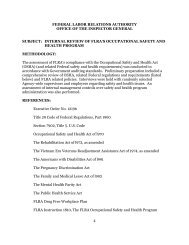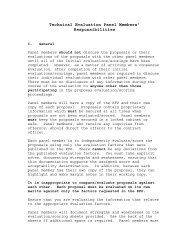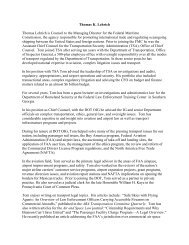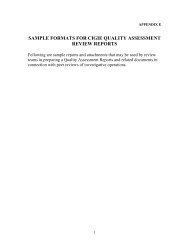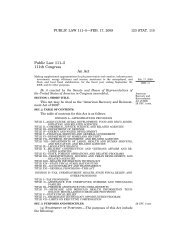GAO-12-208G, Designing Evaluations: 2012 Revision
GAO-12-208G, Designing Evaluations: 2012 Revision
GAO-12-208G, Designing Evaluations: 2012 Revision
Create successful ePaper yourself
Turn your PDF publications into a flip-book with our unique Google optimized e-Paper software.
Case Studies<br />
Typical Designs for<br />
Outcome <strong>Evaluations</strong><br />
Chapter 4: Designs for Assessing Program<br />
Implementation and Effectiveness<br />
In some circumstances, an evaluator may want to use case studies to<br />
explore certain issues in more depth than can be done in more than a few<br />
locations. In single case study evaluations, especially, much attention is<br />
given to acquiring qualitative information that describes events and<br />
conditions from several points of view. The structure imposed on the data<br />
collection may range from the flexibility of ethnography or investigative<br />
reporting to the highly structured interviews of sample surveys. (For more<br />
on the evaluation insights to be gained from ethnography, see <strong>GAO</strong><br />
2003.) Case studies are often used to provide in-depth descriptive<br />
information about how the program operates in the field. If the objective of<br />
the case study is to describe aspects of an issue, provide context, or<br />
illustrate findings developed from a more broadly applied survey, then<br />
selecting a nongeneralizable sample of cases may be appropriate.<br />
Case studies can also supplement survey or administrative data to<br />
explore specific questions about program performance, such as<br />
understanding variation in program performance across locations (for<br />
example, rural versus urban settings), or to identify factors key to program<br />
success or failure. The criteria used for selecting cases are critical to<br />
one’s ability to apply their findings to the larger program. To heighten the<br />
value of the information they provide, cases should be selected carefully<br />
to represent particular conditions of interest (for example, sites with low<br />
versus high levels of performance) and with certain hypotheses in mind.<br />
However, most often, case studies will generate hypotheses rather than<br />
answers to questions such as what factors influence program success.<br />
(For more on case study methodology, see <strong>GAO</strong> 1990, Stake 1995, or<br />
Yin 2009.) For example,<br />
• To identify the causes of a sudden decline in control of an agricultural<br />
pest, evaluators might conduct field observations in the localities most<br />
affected to assess how well key components of the pest eradication<br />
and control program were executed or whether some other factor<br />
appeared to be responsible.<br />
Outcome evaluations address questions about the extent to which the<br />
program achieved its results-oriented objectives. This form of evaluation<br />
focuses on examining outputs (goods and services delivered by a<br />
program) and outcomes (the results of those products and services) but<br />
may also assess program processes to understand how those outcomes<br />
are produced. Outcome evaluations may address questions such as<br />
Page 34 <strong>GAO</strong>-<strong>12</strong>-<strong>208G</strong>




